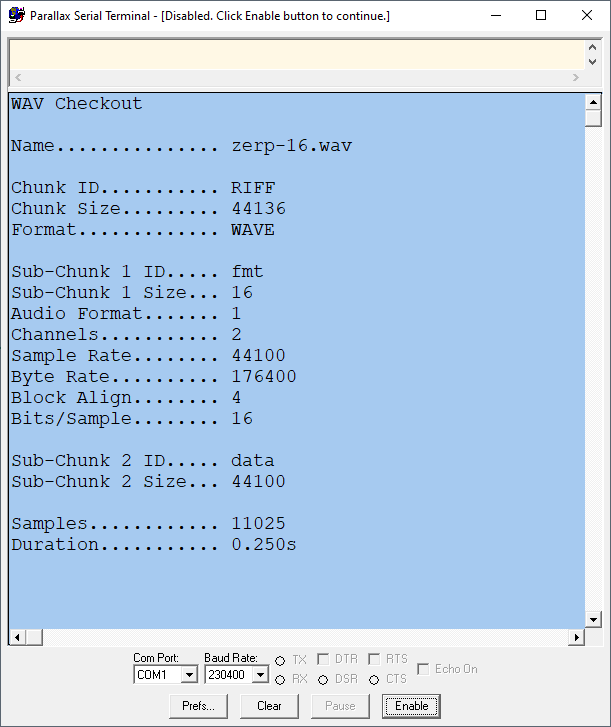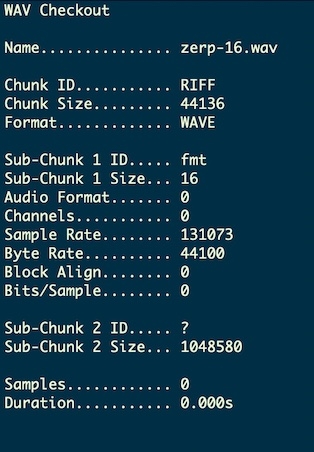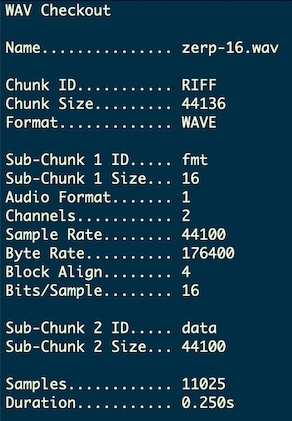WAV Play Experiment
 JonnyMac
Posts: 9,555
JonnyMac
Posts: 9,555
I was inspired by @Baggers to create easy code for playing a WAV file from RAM -- the experimental result is attached. It will play 8- or 16-bit, mono or stereo files. Now that it all seems to be working, I am moving it to a proper object so that I can change stereo volume and playback speed on-the-fly (object will use one cog)
While we don't have structures in Spin, it is nice that with the P2 we no longer have to worry about word or long alignment, which lets us keep a group of variables in the declared order. WAV files have a 44-byte header that is a mix of longs and words. We can declare variables for the header and simply copy them into place with a xxxxmove instruction. Neat. I used bytemove to reinforce the idea of the 44-byte header (wordmove and longmove work, too).
Here are the header variables (notice the size mix)
' WAV header structure ' -- do not change order of these variables long chunkId long chunkSize long format long subChunk1Id long subChunk1Size word audioFormat word numChannels long sampleRate long byteRate word blockAlign word bitsPerSample long subChunk2Id long subChunk2Size
Copying the header from the embedded WAV is this easy now:
bytemove(@chunkId, p_dat, 44) ' copy WAV header to variables
This is the program output to PST (ANSI terminals seem to work, too -- change T_TYPE constant).

Code updated 05 FEB 2021. Includes bug fix (thanks, Chip!) and simplification of the volume control code.



Comments
That's awesome @JonnyMac
flexprop may not agree with PropTool in byte moving the WAV header structure...

Copying the vars one-at-a-time, results in a good display (though the wav file does not play correctly):

There are 2 sounds that are heard (a high volume and a low volume), but they are just a "PHHHT"-like sound
The ZERP file has a 1kHz sine on one channel and a 440Hz sine on the other -- the 16-bit version should sound very clear. Perhaps @ersmith can sort out why this program doesn't work in FlexProp -- it's really pretty straightforward. I only tested with Propeller Tool, but did check the ANSI output using PuTTY.
The audio playback gets what it needs from the header without using any of the displayed global variables. The object I'm writing is based on that inline assembly.
I thought I'd have a look to see if I could help out, but I was only reminded why I have been so turned off by Spin compilers. How does a line a code that seems like it could translate to this:
__byte_move rdbyte tmp, arg02 wrbyte tmp, arg01 add arg02, #1 add arg01, #1 djnz arg03, #__byte_move ret... become this?
__system__bytemove mov _var01, arg01 cmps arg01, arg02 wcz if_ae jmp #LR__0142 loc pa, #(@LR__0136-@LR__0135) call #FCACHE_LOAD_ LR__0135 cmps arg03, #3 wcz if_be jmp #LR__0137 rdlong _var02, arg02 wrlong _var02, arg01 add arg01, #4 add arg02, #4 sub arg03, #4 jmp #LR__0135 LR__0136 LR__0137 mov _var03, arg03 wz if_e jmp #LR__0148 loc pa, #(@LR__0140-@LR__0138) call #FCACHE_LOAD_ LR__0138 rep @LR__0141, _var03 LR__0139 rdbyte _var02, arg02 wrbyte _var02, arg01 add arg01, #1 add arg02, #1 LR__0140 LR__0141 jmp #LR__0148 LR__0142 add arg01, arg03 add arg02, arg03 mov _var04, arg03 wz if_e jmp #LR__0147 loc pa, #(@LR__0145-@LR__0143) call #FCACHE_LOAD_ LR__0143 rep @LR__0146, _var04 LR__0144 sub arg01, #1 sub arg02, #1 rdbyte _var02, arg02 wrbyte _var02, arg01 LR__0145 LR__0146 LR__0147 LR__0148 mov result1, _var01 __system__bytemove_ret retThe truth is, I don't care because I'm not using anything but official Parallax tools at the moment, but those using non-Parallax compilers might want to know why it takes so much code for such a simple function.
Based on the example by dgately, it looks like Flexprop is reordering the variables so that longs are first, followed by words. There's no other context to tell it not to.
This variable reordering is more "normal" in the world of compilers. It's for this reason that struct keyword was invented, it means don't mess with this.
https://stackoverflow.com/questions/9486364/why-cant-c-compilers-rearrange-struct-members-to-eliminate-alignment-padding#9487640
It's too bad computing has diluted the meaning of terminology. I went down the trail of researching record as opposed to structure. But even with records usually being more ridgid in their implementation, they still come with system-dependent padding and alignment concerns such that you can't be sure what you ultimately get.
A data block might still mean an exact and unambiguous representation of how variables are laid out in memory. Consistent in the order they're declared and their size and their absence of secret padding... but even then I'm not so sure.
This is intended behavior for Spin1, but apparently not for Spin2
Well it's simple
So pack your prejudice away for today.
Wow, so glad I use pasm. it's like the early days of C compilers, they were terrible compared to pure asm, it took many many years before they became good.
FlexProp is optimized for speed, not for simplicity of the generated code. In the case of bytemove, it has to handle both upwards and downwards moves (that's a Spin language requirement). For the P2 it takes advantage of the ability to do long moves to speed up the copy in a common case. Finally there's also the FCACHE code that copies the loop into local memory so it can run even faster. All of this adds complication. Yes, if we didn't care about correctness or about speed we could do the straightforward translation you proposed @JonnyMac .
The WAV file problem is, as @Wuerfel_21 and @whicker figured out, do to the object variables being re-ordered the same way as in Spin1. There are some distinct performance advantages to this (un-aligned reads/writes are possible on P2, but slower). If enough objects rely on variable ordering then I'll re-visit this.
@Baggers: FlexProp isn't for everyone, but performance wise it's not "terrible". The code is complicated and "ugly" precisely because it's trying to be fast.
Or to bring the topic back to audio playback: I think P2 is powerful enough to run Tremor, the integer-only OGG decoder. Someone should try that.
That only explains the broken display of the header information, which Dennis sorted on his own. The playback code is atomic and not reliant on the variables used in the display.
@dgately I know why audio playback is not working: The Spin compiler stores the system frequency (clkfreq) at hub address $44, while FlepProp puts the system frequency at hub address 20.
The fix (I'm asking you to do this manually to verify what I did works [I do have proper audio from FlexProp after these changes]).
-- Add a local variable to the play_wav() method called systix.
-- Add this line before the inline pasm code
systix := clkfreq-- Look for this line:
rdlong smpltix, #$44...which you'll find about six lines above the .fix_level label. Change that line to this:
mov smpltix, systixI will try to figure out an elegant way to deal with this incompatibility issue with my WAV player object.
Ye, looks fine to me, so that not working is probably an actual bug to add to the pile. (written before the post above)
Unrelatedly: SAL is not the way to scale a sample. Use SHL. Or if you want proper levels, MUL/MULS or ROLBYTE+SAR
Did I misunderstand SAL? It appears to be a left shift that pads with the original bit0, so $7F is promoted to $7FFF instead of $7F00 as with SHL (assuming a shift value of 8). I've tried both an there is no discernable difference in the audio.
Assembly is not my core strength, and as most of my code is for public consumption I tend to keep things very simple (i.e., public code is not highly optimized). This is the code in question:
.mono8 rdbyte ls, p_wav ' read sample add p_wav, #1 ' point to next subs ls, #$80 ' convert to signed sal ls, #7 ' expand sample, make 1v p-p mov rs, ls ' copy to right channel jmp #.set_volumeMy thoughts: This is an unsigned byte so subtracting $80 gets us to a signed long. The SAL #7 promotes it to 16 bits and then divides by two; this gives a maximum of 1v peak-to-peak from the DAC into the external amplifier.
You have a lot more experience with PASM and A/V coding than I have. I'd love to see how you would do this. I put up this experimental code so that it could be improved before being folded into a general-purpose object.
You understood SAL correctly, it's just that doing it that way effectively halves the resolution, because, for example, $71 becomes $71FF and $72 becomes $7200, which is almost the same value.
I think this would be more correct (untested though)
.mono8 rdbyte ls, p_wav ' read sample add p_wav, #1 ' point to next subs ls, #$80 ' convert to signed muls ls, #$0101 ' expand sample sar ls, #1 ' make 1v p-p mov rs, ls ' copy to right channel jmp #.set_volumeYes, this gets WavFile3 (zerp-16.wav) to play, and it sounds the same as playing that file from my Mac Desktop. The other 3 files are distorted and either very loud (01_milshot.wav) or very quiet (zerp-8 & 8.wav).
You might also want to add support for A-law compression (logarithmic PCM). It's 8 bits per sample, but it sounds so much better than straight 8 bit PCM and takes little code to decompress.
Here's the code for that (in P1 ASM, can be optimized a bit for P2):
'' Decompress A-law '' Compressed sample is in atmp1 '' output is in sfxsample, scale determined by ALAW_BASESHL (= 19 for 31 bit, would be 3 for 15 bit) '' alaw_bias is a constant: 1<<(ALAW_BASESHL-1) '' alaw_leading is a constant: $10<<ALAW_BASESHL xor atmp1,#$55 mov sfxsample,atmp1 and sfxsample,#$0F ' mantissa isolated shl sfxsample,#ALAW_BASESHL add sfxsample,alaw_bias mov atmp2,atmp1 shr atmp2,#4 and atmp2,#7 wz ' exponent isolated if_nz add sfxsample,alaw_leading if_nz sub atmp2,#1 shl sfxsample,atmp2 test atmp1,#$80 wc negnc sfxsample,sfxsampleThanks, I will give that a try.
Again, thank you. The 8-bit uncompressed sounds a bit ratty, so I'll I give this a try. Even running at 200MH (my standard), there are about 4500 system ticks per 44.1kHz sample period -- there is plenty of time to do a bit of simple decompression. That said, my goal is always simplicity for the sake of teaching and inspiring. That code doesn't look bad, though.
I had a late night code review with Chip -- he helped me track down a bug (was setting mode bits backward) and simplify the volume control code. It sounds better and looks good on a 'scope (1v, p-p, centered at 1v). I will move this code into a cog that will allow the user to start and stop playback at will, to put playback on hold for later release, to change left and right volume levels (0% to 100%) on-the-fly, and to change the playback rate (50% to 200%) on the fly.
Updated code is in the first post. If you're a FlexProp user, you'll have to make a small adjustment -- it's noted in the file.